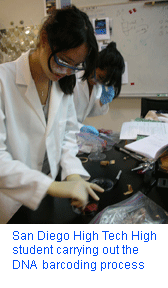High school students help demonstrate practicality, utility of DNA barcoding
 High school students in San Diego are using DNA barcoding to survey life in San Diego Bay, ranging from invasive mussels, to gastropod egg masses on eel grass, zooplankton and endangered species. Under leadership of Dr. Jay Vavra, students developed a simplified protocol for DNA extraction and amplification that can be performed in the high school’s biotechnology laboratory, and successfully identified dried jerky meat from ostrich, turkey, and beef. They have established a collaboration with East African graduate students to apply this approach to identifying bushmeat from endangered species in local African markets.
High school students in San Diego are using DNA barcoding to survey life in San Diego Bay, ranging from invasive mussels, to gastropod egg masses on eel grass, zooplankton and endangered species. Under leadership of Dr. Jay Vavra, students developed a simplified protocol for DNA extraction and amplification that can be performed in the high school’s biotechnology laboratory, and successfully identified dried jerky meat from ostrich, turkey, and beef. They have established a collaboration with East African graduate students to apply this approach to identifying bushmeat from endangered species in local African markets.
 Just two years ago, in Syst Biol 55: 844, 2006 some taxonomists worried whether DNA barcoding would ever be useful: “The truth is that DNA barcoding will not have any meaningful use for the general public and even when a portable barcoder becomes available it will not lead to any increase in the biological literacy of the man in the street.” Authors Cameron et al might want to visit their local high school!
Just two years ago, in Syst Biol 55: 844, 2006 some taxonomists worried whether DNA barcoding would ever be useful: “The truth is that DNA barcoding will not have any meaningful use for the general public and even when a portable barcoder becomes available it will not lead to any increase in the biological literacy of the man in the street.” Authors Cameron et al might want to visit their local high school!
For high school students DNA barcoding seems as natural as texting. You can analyze DNA to identify species? Sure. You only need a trace sample, like a hair or a bit of dried skin? Sure, just like CSI shows. On the other side, many identification keys are not practical for most persons who would like to identify what is in their backyard.
This entry was posted on Wednesday, June 4th, 2008 at 10:21 pm and is filed under General. You can follow any responses to this entry through the RSS 2.0 feed. Both comments and pings are currently closed.
June 5th, 2008 at 3:23 am
Brilliant! Thanks for sharing this, Mark. It’s an excellent model for those of us who want to integrate research and education through DNA barcoding.
June 12th, 2008 at 3:55 pm
Wow, this is incredible.
I wish I had these types of programs in highschool
June 29th, 2008 at 8:40 am
Thanks for the post.Thats fantastic and incredible.
June 29th, 2008 at 8:47 pm
This is a really good type of activites that school should employ. Definitely helps to improve the education system. yes, i have these type of activities in my high school.
October 20th, 2010 at 10:32 am
This is an incredible post. yes, I know, its a little bit old, but still – impressive!